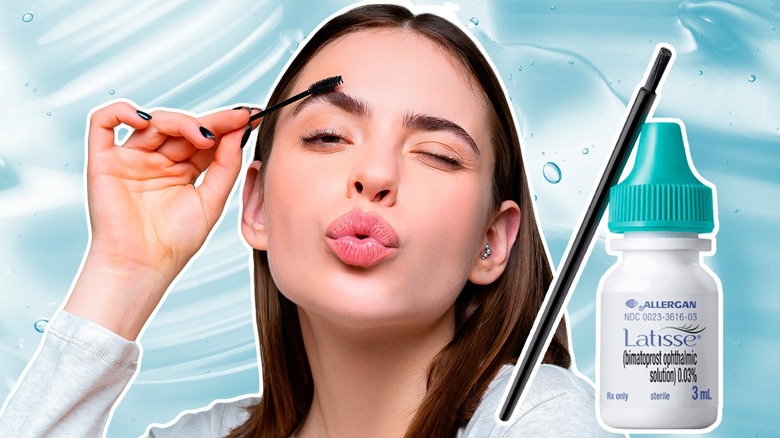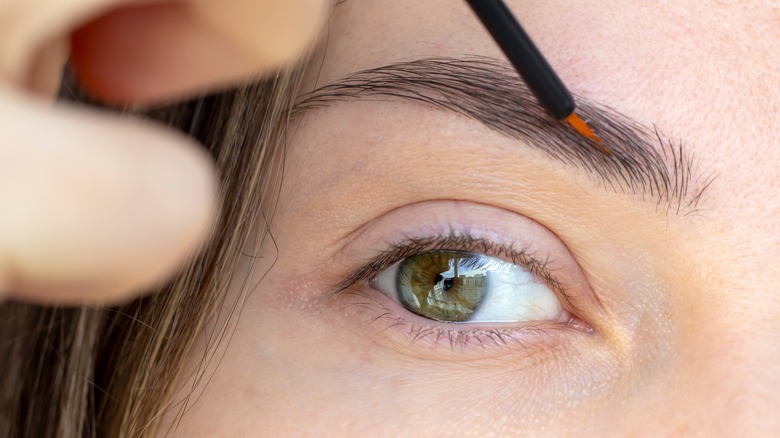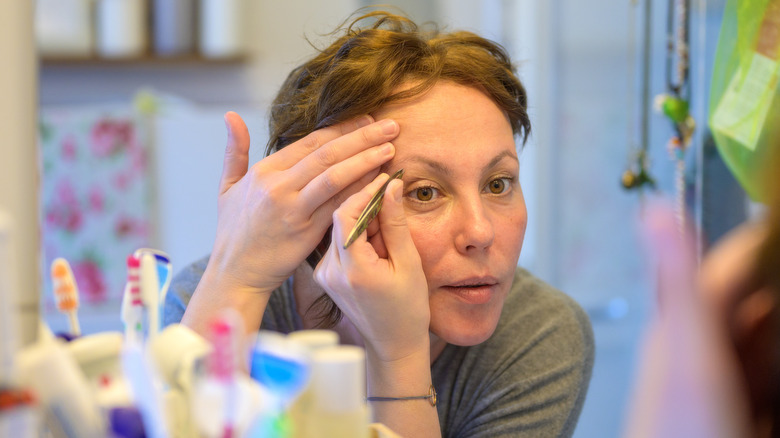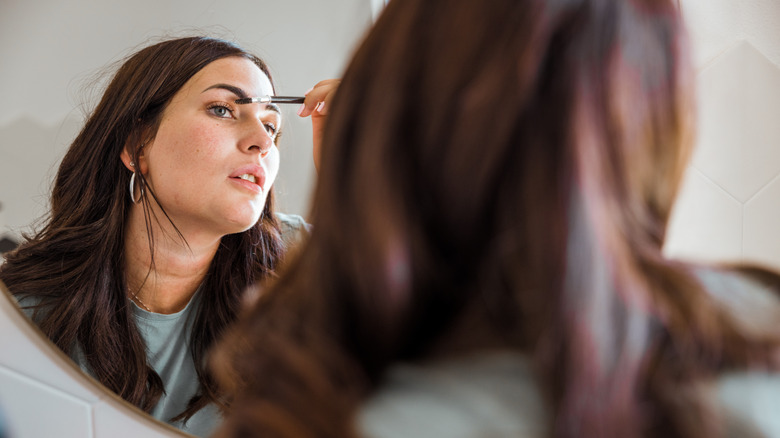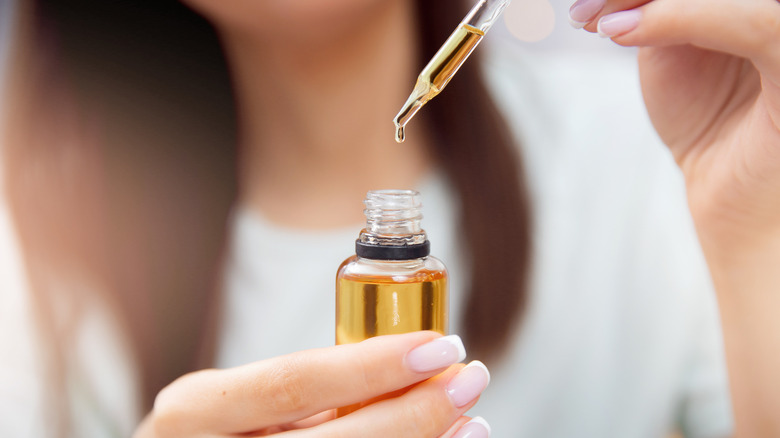How Does Latisse For Eyebrow Growth Actually Work? Here's What To Know
Sometimes, doctors come up with beauty solutions that drugstore finds just can't compete with, and that's the case with Latisse. The prescription serum, formulated to boost lash growth, was approved by the U.S. Food & Drug Administration (FDA) in 2008. From then on, a doctor's note was all it took to get longer, stronger eyelashes — no need to keep experimenting with over-the-counter remedies and mascaras.
Soon after Latisse hit pharmacy shelves, some people discovered another use for the solution: enhancing their eyebrows. According to ABC News, doctors and patients realized that the prescription may help boost brow hair growth, even if the serum wasn't originally intended to be used this way.
Flash forward several years later, and Latisse is still only approved by the FDA for growing eyelashes — not eyebrows. Still, physicians are free to prescribe the medication for brows at their discretion. "Latisse is safe to use on the eyebrows, although it is considered an off-label use," Dr. Anthony Youn, a plastic surgeon, told NewBeauty. "Many doctors are testing it on their patients as a way to regrow eyebrows that are overplucked and waxed." However, there are several things to know before you sprint to your doctor's office in search of bolder brows.
How Latisse works for hair growth
Latisse is considered a game-changer for lash growth, but its discovery actually came by accident. According to dermatologist Dr. S. Manjula Jegasothy, the original Latisse formula was actually an eye drop meant to treat glaucoma. "When it was used for this purpose, more than 10 years ago, many ophthalmologists and patients found that it would grow their eyelashes as well," Dr. Jegasothy shared with NewBeauty.
It's still unclear how exactly Latisse works, though the drug's official website explains that its active ingredient (bimatoprost) may play a role in extending the hair's growth cycle. This allows more time for new growth, resulting in fuller, longer lashes.
How does this all translate to eyebrow growth? According to Healthline, Latisse is thought to work on brows just as it does on lashes: by increasing the hairs' growth phase. In theory, you could expect less sparseness and hair loss after applying Latisse to the eyebrows — bring on full, fluffy brows.
Here's how to use Latisse on your eyebrows
Prescription Latisse, complete with its included set of applicators, is meant to be brushed on the lash line nightly. If you want to use Latisse for eyebrows, the process is almost identical, according to Ro, a telehealth service that prescribes Latisse to patients. First, wash your face, which includes removing any makeup that may be on your eyebrows and following your regular nighttime skincare routine. Then, squeeze a drop of Latisse onto an applicator and sweep the solution on one eyebrow at a time. The liquid should be evenly distributed so that all hairs and sparse spots are covered.
Generally, there's no need to apply Latisse in the morning or more than once per day, even if you forgot an application the night before. The prescription could cause itching and irritation, so it's crucial to not overdo it. Moreover, be careful not to layer on the serum, as it could drip onto your skin or into your eyes. If you realize you have too much Latisse on your brows, simply dab away the excess with a clean tissue.
Is Latisse actually effective for brows?
Though Latisse isn't officially approved for use on the eyebrows, there's evidence that the prescription formula can grow thicker, darker brows. A 2019 study published in the journal Dermatologic Surgery concluded that bimatoprost, the active ingredient in Latisse, increased eyebrow hair thickness with minimal side effects or safety concerns. A 2018 research review published in Drug Design, Development and Therapy also found the ingredient effective and safe when used to treat eyebrow hair loss.
A 2016 study published in Dermatologic Surgery stated similar findings, comparing a group of participants who treated their eyebrows with a bimatoprost 0.03% formula (similar or identical to Latisse's formula) and a control group. However, it's worth noting that only about 18% of bimatoprost users in the study reported being very satisfied with their results. In other words, formulas like Latisse likely work for eyebrows, though you shouldn't expect life-changing results.
Latisse can't treat all eyebrow concerns
If you've ever tweezed your eyebrows to copy the trending look of the era (hello, thin '90s brows) and then tweezed and tweezed some more, you might be suffering the consequences now. And unfortunately, Latisse might not reverse the damage that's already been done. As Melissa Piliang, a dermatologist at the Cleveland Clinic, revealed to The New York Times, no growth formula will undo chronic overplucking. "You could put on all of these products, and the hair around it will respond, but it won't come back in that little spot," she said.
When you yank hair out from the same spot over and over, it can cause physical trauma to the hair follicle, notes Healthline. Even aggressively applying pencil and other eyebrow cosmetics could cause similar damage. When this trauma is repeated, the hair may no longer be able to grow in those areas.
Thankfully, if you only overplucked once or twice, you might still be able to regrow your eyebrows with Latisse. "The good news is, eyebrows can be encouraged to grow back, as long as the eyebrow follicles have not been permanently scarred," dermatologist Dr. Jessica Wu told Vogue.
Does Latisse make hair fall out?
You can expect Latisse to boost your brows within seven to nine months, according to Ro. Unfortunately, if you stop using the prescription formula, your hairs will likely return to its previous condition within a few months.
In some cases, this might mean the new hairs you've grown will fall out. Dr. Peter A. Aldea, a board-certified plastic surgeon and doctor on RealSelf, states that if you suddenly stop using Latisse, "a large number of the [hair] follicles would go into their dormant stage and the lashes would fall off until the follicles wake up and each re-grows a hair." For this reason, Dr. Aldea suggests switching to using Latisse less often rather than cutting it from your routine altogether.
For brows specifically, eyebrow artist Azi Sacks has another solution. "What I tell clients to do is if they're going to use Latisse, coat it with castor oil at night— and create a relationship with the castor oil, and to not stay dependent on the Latisse," Sacks explained to The Zoe Report. Then, continue using castor oil when you decide to ditch your Latisse prescription.
Latisse alternatives for eyebrow growth
Overall, Latisse can be an effective option for eyebrow growth with just a couple of cons to watch out for. But another drawback to keep in mind is that it's a prescription, meaning you can't just pick it up on a whim. You'll need your doctor's approval, plus the money (or insurance coverage) to afford the hair-booster-in-a-bottle.
If you're not too keen on visiting the doctor every time you need a refill, there are countless over-the-counter alternatives. Brow expert Azi Sacks already shouted out castor oil and other professionals agree the oil could be an effective remedy. "You can help the brows grow faster and healthier by using castor oil or vitamin E and aloe vera gel. These are all great natural boosters," Suman Jalaf, eyebrow expert and founder of Suman Brows, shared with Stylist.
If you'd prefer a Latisse-adjacent concoction instead, look for beauty aisle brow serums that contain isopropyl cloprostenate, as Dr. Geeta Yadav, a board-certified dermatologist and founder of Facet Dermatology, recommended to Glamour. Whether going the prescription or OTC route, watch out for any signs of irritation, such as redness or eye discomfort, and consult with your doctor if you experience any side effects.
